Back
in the spring we had the pleasure of working with a client and turn her somewhat dysfunctional kitchen space into a calm, functional, and attractive
room in her home. Lucky for us, we were able to help her transform her kitchen into the custom kitchen of her dreams!
We replaced the outdated natural oak cabinets with new light grey painted Woodland cabinetry in the Hill door style. We also swapped out the appliances, and painted the walls and trim.
We installed Berwyn Cambria quartz counter tops and replaced the outdated natural oak cabinets with light grey painted Woodland cabinets in the traditional Hill door style.
We brought the cabinets all the way up to the ceiling to make the ceiling feel taller and the room more spacious.
A subway tile back splash was installed with herringbone detailing, which nicely complimented the new stainless steel appliances that were installed in the kitchen.
One of the client's requests was to add more functional counter space to the kitchen. We installed permanent cabinetry to the side of the kitchen entryway to offer more counter space, storage, and an aesthetically pleasing place to put the microwave. We hope our client was as pleased with the transformation as we were - we think it looks beautiful!!
Finally, the old yellow floor tiles were removed and replaced with beautiful new grey slabs in a contemporary color, texture, and shape.
We are so glad we had the opportunity to work with this client and we hope she enjoys her kitchen for many years to come!!
Thanks for reading this Customer Close-up. If you have any questions, feel free to ask them in the comments below!
Make sure to check back every month for
more kitchen remodeling ideas, information, and more. Until then!



























